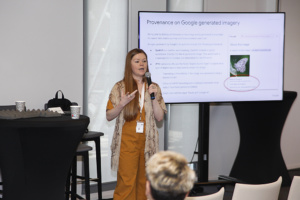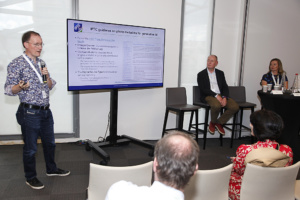Categories
Archives

Last week CEPIC, the “centre of the picture industry”, held its annual Congress in Juan-les-Pins in France. This was the second time that the event was held at the Palais du Congres in Juan-les-Pins near Antibes, which is proving to be a great venue for the Congress with many repeat visitors who also attended last year.
IPTC was well represented at the event, with Managing Director Brendan Quinn presenting on two panels and many other IPTC members involved in presentations, panels or simply attending the event. IPTC members either presenting or in attendance included Google, Shutterstock, Getty Images, ANSA, IMATAG, PA Media / Alamy, TT, dpa, Adobe, Xinhua, Activo, APA, European Pressphoto Agency EPA and possibly more that we have missed!

One of the highlights for us was the Provenance and AI panel moderated by Anna Dickson, who until recently was with Google but is now with another IPTC member, Shutterstock. Presenters on this panel included Katharina Familia Almonte, product manager at Google, Andy Parsons, Director of the Content Authenticity Initiative (although Brendan ended up presenting his slides due to it being 4.30am for Andy in New York at the time!); Mathieu Desoubeaux, CEO of IPTC startup member IMATAG, and Brendan Quinn, Managing Director of IPTC.
Brendan used the opportunity to introduce the IPTC Media Provenance Committee and the work that the IPTC is doing on creating a C2PA Trust List for media organisations. Brendan put out a call for other media organisations who may be interested in joining the next cohort of certificate holders who will be able to obtain a certificate stored on the trust list and use it to cryptographically sign their media content. The discussion went on to look at the issues around using both C2PA and watermarking technology to protect image content.
Later in the day was the panel “Where Law and Technology Meet.” Moderated by Lars Modie (CEPIC, previously of IBL Bildbyrå / TT in Swededn) with speakers: Serguei Fomin (IQPlug, IPTC CEPIC representative), Brendan Quinn (IPTC), Franck Bardol (University of Geneva), Nancy Wolff (partner at the intellectual property, media and entertainment law firm of Cowan, DeBaets, Abrahams & Sheppard, LLP and DMLA counsel) and Katherine Briggs of Australian agency Envato which was recently acquired by Shutterstock.

At this panel, Brendan outlined IPTC’s recent guidance on metadata for generative AI images. This includes the Digital Source Type property but also guidance on using the Creator, Contributor, and Data Mining properties to signal ownership and rights licensing information associated with images, particularly for engines that “scrape” web content to train generative AI models.
Many stimulating conversations always make the CEPIC Congress a valuable event for us to attend, and we are already looking forward to next year’s instalment.